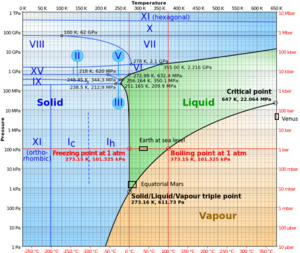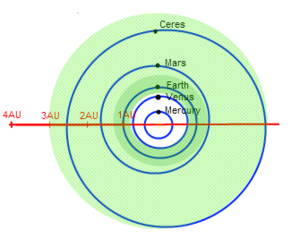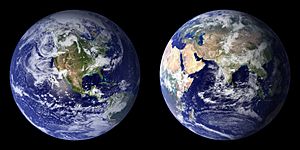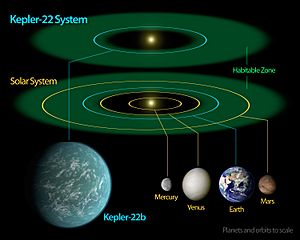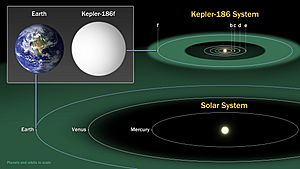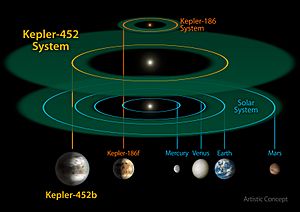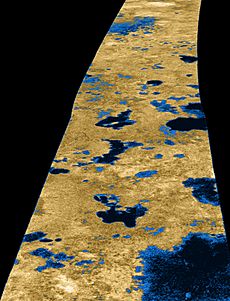Circumstellar habitable zone facts for kids
In astronomy, the circumstellar habitable zone (CHZ) is a special area around a star. It's where a planet could have liquid water on its surface. Liquid water is super important because all life on Earth needs it to survive. Scientists believe that if we find liquid water, we might find extraterrestrial life too!
This special zone is also called the Goldilocks zone. It's like the fairy tale "Goldilocks and the Three Bears". In the story, Goldilocks picks what's "just right"—not too hot, not too cold. For planets, the Goldilocks zone means it's not too close to the star (too hot) and not too far (too cold). It's "just right" for liquid water.
Since this idea came out in 1953, we've found many planets in these zones. Some star systems even have several planets in their Goldilocks zone! Many of these planets are bigger than Earth, like super-Earths or gas giants. They are easier for us to spot. In 2013, scientists thought there could be as many as 40 billion Earth-sized planets in the habitable zones of stars like our Sun or smaller red dwarfs in the Milky Way galaxy.
Proxima Centauri b is the closest known exoplanet to us. It's about 4.2 light-years away. This planet orbits in the habitable zone of its star. Scientists are also interested in moons around planets in the CHZ. These moons might even be more common than habitable planets!
Over time, scientists have learned that liquid water can exist in other places too. It's not just on the surface of planets in the CHZ. For example, there could be huge amounts of water deep inside planets or moons. This water might be heated by things like tidal heating (from a planet's gravity) or radioactive decay. So, liquid water might even be found on rogue planets (planets that don't orbit a star).
Contents
How We Found the Goldilocks Zone Idea
The idea of a "just right" distance from a star for liquid water goes way back. Even Isaac Newton thought about it in his famous book Principia.
The actual concept of a circumstellar habitable zone was first talked about in 1913 by Edward Maunder. Later, in 1953, Hubertus Strughold used the word "ecosphere" for areas where life could appear. That same year, Harlow Shapley wrote about the "Liquid Water Belt." Both scientists stressed how important liquid water is for life.
In 1959, Su-Shu Huang first used the term "habitable zone." He connected it to finding life beyond Earth. He also thought that finding life might be rare in multiple star systems because of their unstable gravity.
In 1964, Stephen H. Dole wrote a book called Habitable Planets for Man. He estimated there could be about 600 million habitable planets in the Milky Way! Science fiction writer Isaac Asimov also helped make the idea of the Goldilocks zone popular. The term "Goldilocks zone" itself became common in the 1970s.
In 1993, astronomer James Kasting created a detailed model for the habitable zone around exoplanets. This helped us understand it better.
Later, in 2000, scientists Peter Ward and Donald Brownlee came up with the idea of a "galactic habitable zone." This is a region in a whole galaxy where life is most likely to appear. It's not too close to the galaxy's center (where radiation is too strong) and not too far (where there aren't enough heavy elements).
Scientists are still learning about the CHZ. They've even suggested other "habitable zones" for different liquids, not just water. In 2013, they proposed a "circum planetary habitable zone." This is the area around a planet where its moons could have liquid water without being pulled apart by gravity or getting too hot.
It's important to remember that being in the CHZ doesn't guarantee a planet has life. A planet's surface conditions depend on many things. So, scientists are careful not to say a planet is "habitable" just because it's in the CHZ.
Finding the Goldilocks Zone
Whether a planet is in the Goldilocks zone depends on its orbit, its mass, and how much energy its star gives off. Bigger planets, like super-Earths, can have thicker atmospheres and stronger magnetic fields. This means they might be able to hold onto liquid water even if they are a bit further out.
Scientists now talk about two types of habitable zones:
- A conservative habitable zone is where smaller planets like Earth can stay habitable.
- An extended habitable zone is a bit larger. Planets like Venus, with a strong greenhouse effect, might have the right temperature for liquid water here.
Our Solar System's Goldilocks Zone
Estimates for the Sun's habitable zone range from 0.38 to 10.0 astronomical units (AU). One AU is the distance from the Earth to the Sun.
- Venus is at 0.72 AU. Its orbit touches the inner edge of the zone. But Venus has a super strong greenhouse effect, making its surface too hot for liquid water. Water there would just turn into vapor.
- Mars is at 1.52 AU. Its orbit is within some estimates of the habitable zone. But Mars is too small to hold onto a thick atmosphere. So, liquid water can only exist for very short times in its lowest areas.
- Only Earth (at 1.00 AU) is clearly within the most common estimates of the Sun's habitable zone.
Even though Venus and Mars don't have liquid water now, studies suggest they might have had it in the past. This means liquid water might have been more common than we thought!
Scientists believe that for complex life to exist, liquid water must be stable for a long time. So, most estimates for the habitable zone are based on what would happen if Earth or Venus were in different orbits.
Some scientists think that planets with very thick atmospheres, or super-Earths, could have liquid water even farther from the Sun. But we don't have examples of such planets in our Solar System to study.
Looking for Goldilocks Zones Around Other Stars
Scientists use math to figure out the Goldilocks zone around other stars. For example, if a star is only 0.25 times as bright as our Sun, its habitable zone would be closer to it. It would be at half the distance from the star compared to our Sun's zone.
However, it's more complicated than that. Each star is different.
Star Types and Systems
Some scientists think the Goldilocks zone only works for certain types of stars.
- Very hot stars, like O-type stars, might not even form planets because their strong light blows away gas and dust.
- Stars smaller than the Sun, like red dwarfs, have their own challenges. Planets orbiting them might be "tidally locked". This means one side always faces the star (super hot) and the other side always faces away (super cold). But newer models show that these planets could still have stable temperatures with lots of clouds.
- Even white dwarfs (dead stars) or brown dwarfs (failed stars) might have a temporary habitable zone if planets move closer to them.
How Stars Change Over Time
The Goldilocks zone also changes as a star gets older.
- Hot, massive stars don't live very long. Their habitable zones change quickly, which isn't good for life to develop.
- Red dwarf stars, however, can live for hundreds of billions of years! This gives planets around them lots of time for life to appear.
- Even our Sun is getting brighter over time. In the future, Earth will eventually move out of the Sun's habitable zone.
To deal with this, scientists use the idea of a continuously habitable zone. This is a region where planets can have liquid water for a very long time.
Red dwarf stars can also have huge stellar flares. These flares could blast away a planet's atmosphere and water. But after about 1.2 billion years, red dwarfs usually become more stable.
When a star becomes a red giant (like our Sun will), its habitable zone moves much farther out. For our Sun, this new zone would be from 7 to 22 AU. At this stage, Saturn's moon Titan might become warm enough for liquid water. However, strong stellar winds from the red giant could strip away atmospheres from smaller planets.
Desert Planets
A planet's atmosphere also affects its Goldilocks zone.
- Desert planets (with very little water) have less water vapor in their atmosphere. This means they have a weaker greenhouse effect. So, they could have liquid water closer to their star than Earth is to the Sun.
- Because they have less water, there's also less ice to reflect heat. This means the outer edge of a desert planet's habitable zone could be farther out.
Other Important Things
For a planet to have liquid water, it needs a source of water. On Earth, water might have come from icy comets hitting us, or from gases released from inside the planet.
A planet also needs a thick enough atmosphere to keep liquid water on its surface. If the atmospheric pressure is too low (below about 15 millibars), water can't stay liquid.
Scientists have also found that if a planet has a lot of hydrogen gas from volcanoes, its habitable zone can be much bigger. This hydrogen acts like a super strong greenhouse gas.
Planetary moons can also be habitable! But they need to be far enough from their giant host planet so that its gravity doesn't heat them up too much (like Io, a volcanic moon of Jupiter). They also need to be close enough to stay in orbit around their planet.
A planet with a very stretched-out orbit (high orbital eccentricity) might only be in the Goldilocks zone for part of its year. This would cause huge temperature changes. Life on such a planet might have to go into hibernation during the cold times.
Amazing Discoveries Beyond Our Solar System
Scientists are constantly finding new exoplanets. In 2015, they thought Kepler-62f, Kepler-186f, and Kepler-442b were the best candidates for being potentially habitable. These planets are hundreds of light-years away. Kepler-186f is very close to Earth in size.
A 2013 study suggested there could be 95 to 180 billion habitable planets in the Milky Way! But we've only found a tiny fraction of them so far.
Early Finds
The first exoplanets found in the CHZ were huge gas giants. Even though they were big, scientists thought they might have large, Earth-like moons with liquid water.
- 70 Virginis b (1996) was nicknamed "Goldilocks" but turned out to be too hot.
- 16 Cygni Bb (1996) has a very stretched orbit, causing extreme seasons.
- Gliese 876 b (1998) and Gliese 876 c (2001) are gas giants that might have large moons.
- HD 28185 b (2001) orbits entirely within its star's habitable zone. It could have habitable moons.
- HD 69830 d (2006) and 55 Cancri f (2007) are also gas giants in their stars' CHZs.
At the time, we didn't have the technology to find moons around these distant planets. So, scientists were more interested in finding planets with solid surfaces.
Habitable Super-Earths
In 2007, the discovery of Gliese 581c was very exciting. It was the first super-Earth found in a habitable zone. However, it was later found to be too extreme, like Venus. Gliese 581 d was another planet in that system that seemed more promising.
In 2011, Kepler-22 b was discovered by the Kepler space probe. It was the first exoplanet found orbiting a star like our Sun. It's 2.4 times the size of Earth and might be an "ocean planet."
Gliese 667 Cc, found in 2011, is another super-Earth in a habitable zone. It's considered one of the most Earth-like planets we know.
Other super-Earths found in habitable zones include:
- Gliese 163 c (2012)
- HD 40307 g (2012)
- Tau Ceti e and Tau Ceti f (2012) – though Tau Ceti f is now thought to be uninhabitable.
Near Earth-sized Planets and Sun-like Stars
Recent discoveries have found planets closer to Earth's size. "Earth-sized" usually means a planet up to 1.9 times Earth's mass or 1.5 times Earth's radius. Planets bigger than that tend to have a lot of gas, not just rock.
A solar analog (or "solar twin") is a star that looks like our Sun. No perfect solar twin has been found yet. But some stars are very similar.
Using data from the Kepler Space Observatory, scientists think that 22% of Sun-like stars in the Milky Way have Earth-sized planets in their habitable zones.
Some exciting discoveries include:
- Kepler-69c (2013): An Earth-sized planet (1.7 times Earth's radius) orbiting a Sun-like star in its CHZ.
- Kepler-62e and Kepler-62f (2013): Likely solid planets, 1.6 and 1.4 times Earth's radius, orbiting a Sun-like star.
- Kepler-186f (2014): The closest in size to Earth (1.1 Earth radii) found by the transit method.
- Kapteyn b (2014): A possible rocky world, about 4.8 Earth masses, orbiting a red subdwarf star.
- Kepler-438b and Kepler-442b (2015): Near-Earth-sized and likely rocky. Kepler-438b gets strong flares, so it might not be habitable.
- Kepler-452b (2015): 50% bigger than Earth, likely rocky, and orbits a Sun-like star in its habitable zone.
- TRAPPIST-1 system (2016): Three tidally-locked planets orbiting in the habitable zone of a very cool dwarf star. This discovery suggests many more habitable planets might exist around small, cool stars.
- LHS 1140b (2017): A super-dense super-Earth, 39 light-years away. It's 6.6 times Earth's mass and 1.4 times its radius.
- Ross 128 b (2017): About 1.35 times Earth's mass, likely rocky, and orbits a "quiet" red dwarf star just 11 light-years away.
- K2-155d (2018): About 1.64 times Earth's radius, likely rocky, in its red dwarf star's habitable zone.
- GJ 357 d (2019): A super-Earth orbiting the outer edge of a red dwarf's habitable zone.
- K2-18b (2019): This planet is special because scientists found water vapor in its atmosphere! It orbits in the habitable zone of its red dwarf star.
| Notable exoplanets – Kepler Space Telescope |
|---|

(Kepler-62e, Kepler-62f, Kepler-186f, Kepler-296e, Kepler-296f, Kepler-438b, Kepler-440b, Kepler-442b) (Kepler Space Telescope; January 6, 2015). |
Life Beyond the Goldilocks Zone
Liquid water can exist even outside the Goldilocks zone. For example, Saturn's moons Titan and Enceladus, and Jupiter's moons Europa and Ganymede, all have huge subsurface oceans. These oceans are hidden under thick ice shells.
Outside the CHZ, heat from tidal heating (gravity pulling on a moon) or radioactive decay can keep water liquid. Some scientists even think that "rogue planets" (planets floating in space without a star) could have subsurface water.
On Earth, life has been found more than 6 kilometers (3.7 miles) below the surface! This suggests that life might be common in hidden, subsurface habitats on other worlds too.
Some scientists also wonder if life could exist using different liquids instead of water. For example, astrobiologist Christopher McKay suggested that methane (CH4) could be a liquid for "cryolife" (cold life). The Sun's "methane habitable zone" would be around Titan's orbit. Titan has lakes and rain made of methane, making it a good place to look for this type of life.
Why the Goldilocks Zone Matters for Smart Life
The Rare Earth hypothesis suggests that complex, intelligent life is very rare. It says that the Goldilocks zone is just one of many things needed for life to appear. It's not just about having surface water, but also about supporting other things like plate tectonics and photosynthesis (which makes oxygen).
However, other scientists think that smart life could appear outside the CHZ. It might evolve in underground environments, use different types of chemistry, or even get energy from nuclear reactions.
On Earth, some complex life forms can survive extreme conditions. For example, tiny creatures called Tardigrades can survive super hot or super cold temperatures, and even the vacuum of space! Some fungi can also live and grow in conditions like those on Mars.
Humans need a lot of energy, oxygen, and food from sunlight. If we want to live on other planets, we'd prefer "Earth analogs" in the CHZ. These planets would have the right temperature, gravity, atmosphere, and water. This would make it easier for us to live there without needing spacesuits all the time.
The Goldilocks zone is very important for scientists looking for intelligent life in the universe. The Drake equation, which tries to estimate the number of intelligent civilizations, includes a factor for planets in the CHZ. If there are many such planets, it suggests life might be common. If there are few, it suggests life is rare.
Scientists involved in the search for extraterrestrial intelligence (SETI) often focus on planets in the CHZ. They listen for signals from these areas. Some messages from Earth have even been sent to star systems known to have planets in their Goldilocks zones, hoping to make contact!
See also
 In Spanish: Zona de habitabilidad para niños
In Spanish: Zona de habitabilidad para niños
- Habitability of red dwarf systems
- Habitability of yellow dwarf systems
- Habitability of K-type main-sequence star systems
- Habitability of binary star systems
- Habitability of neutron star systems
- Habitability of F-type main-sequence star systems



